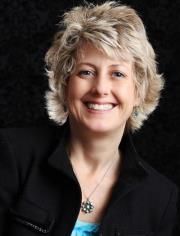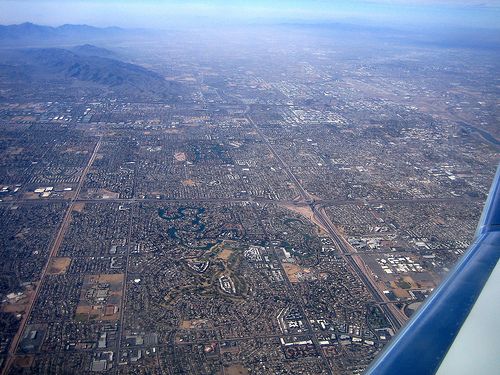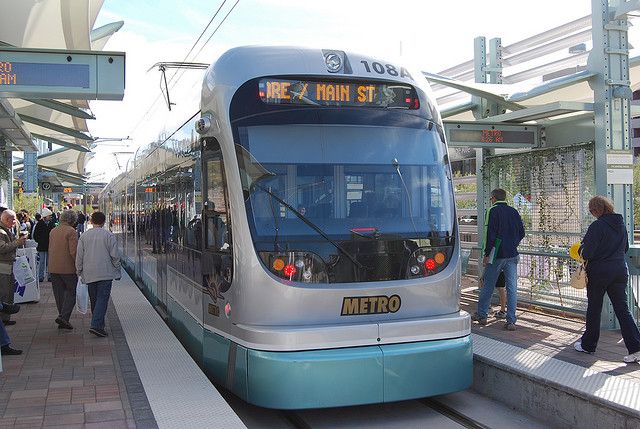As we prepare for the 21st Congress for the New Urbanism conference later this spring, Next City will run interviews with a number of the event’s speakers. Read the first two installments here and here.
In many ways, Shannon Scutari is responsible for bringing real transit to one of America’s most sprawling cities. Having spent 15 years in the Arizona Department of Transportation and other government offices, she helped find the support and funding to make real what many then considered a pipe dream: Light rail in the cities of Phoenix, Tempe and Mesa. Today, as director of the Sustainable Communities Collaborative, Scutari oversees a $20 million fund to help facilitate transit-oriented development along this light rail corridor.
Here, Scutari explains why Arizona can no longer bank on sunshine and how not wanting to become L.A. helped make Phoenix light rail a reality.
Next City: The Sustainable Communities Collaborative’s mission is to build transit-oriented development along the 20-mile light rail corridor in Phoenix, Tempe and Mesa. I’m interested in learning about the process of getting these three cities on the same page.

Scutari
Shannon Scutari: The light rail line has provided transportation that is forcing the three cities to collaborate in a way that they have never had to collaborate before. It’s that ability to operate the system together. Each one of the cities does still contribute its own operating funding, but there is now regional funding that is going to support other types of transportation options outside of just vehicles and highways. That has changed the paradigm significantly. So what the Sustainable Communities Collaborative is doing is capitalizing on that arrangement and the fact that those three cities are working with each other now.
The citizens, they don’t know which city they’re really in when they’re riding the rail. It’s 20 miles goes through all three cities. So the three mayors, political leaders and community activists are starting to recognize that if it’s not seen as a corridor then the service level isn’t as high as it could be. That’s been a real positive, and the Collaborative has reinforced that from the outside. When we launched the fund two years ago, we got all three of the mayors together. That rarely happens — I don’t know if it has ever happened — when all three mayors came together, on one day, and all put their support behind something. The $20 million got people’s attention. A commitment from funders outside of Arizona, basically showing that they were willing to take a risk on this corridor, but only if those three cities were working with each other — that was a one of the big catalysts.
NC: Light rail in the Phoenix area is something that would have been hard for most to imagine not too long ago. Now it’s the 12th busiest light rail system in the country. Can you describe what it was like when the idea of implementing light rail in Phoenix was first introduced, and how it finally came about?
Scutari: In your wildest dreams you could never have imagined a train in the metropolitan Phoenix area. A handful of people had a vision and could see that happening, and those people had to attract the influence of a lot of different areas within the Valley to get the kind of support that was needed to get this through the legislature, so that there would be funding sources for something other than highways and arterial streets. It took a multifaceted government relations effort just to get this on the ballot.
Having the money was a big issue. Folks said nobody would ever support it. Nobody could imagine a train, and if you can’t imagine it, then why would you think the voters would vote for it? What ended up happening was we did some polling, and we found that folks would vote for transit and rail, because they wanted balance. People were afraid that if we didn’t have balance in transportation options, we would become L.A. That emotional response that we picked up in the polling, we capitalized on that. Whether or not they could envision any transit working in a sprawling metropolis, [residents] thought, “other people will ride it, and that means less congestion on the freeways for me.” That was about as far as we could get: We could get folks to envision that [light rail] would make their lives easier if there was a balance in the plan. It’s really hard to describe how foreign the concept was to such a car-centric culture.
NC: Well, the Phoenix metro area is enormous. Once the area around the light rail corridor develops, is there any plan to extend the Collaborative’s focus to elsewhere in the region?
Scutari: Glendale is the fourth city that is a partner at Valley Metro, and anticipates rail connecting Phoenix over to the West Valley. We have already had conversations with elected officials and the staffs in Glendale about including them in the collaborative. We need to really focus on the existing 20 miles, which is a huge undertaking in itself — we have to focus on existing areas [within the 20-mile corridor] that we think are going to show some successful examples of transit-oriented development. And then we will get to the point where we will add another municipality to the partnership.
NC: As briefly as possible, tell me what a commuter rail line from Phoenix to Tucson can do for Arizona?
Scutari: I hate to say “commuter.” I think “intercity” is the best way to say it, because we could have both a local and an express, and sometimes when you say “commuter” people think, “It’s not going to go fast enough.” But we need both local and express. To give a simple answer, it can transform growth and development patterns within the Sun Corridor because it will focus around hubs instead of around highway interchanges.

The Phoenix area seen from above. Credit: Flickr user shoseph
NC: Sun Belt cities took a disproportionate hit during the recession. Recent reports have indicated that if nothing else, the economic downturn helped slow down the rapid pace of growth at the urban fringe in cities across the country. How has this shaken out in Phoenix? Has there been an appreciable conversation about changing the city’s development habits in the wake of the housing bubble?
Scutari: Absolutely. A lot of the momentum that we’re building, and that we’re creating new political and community allies around, is… a couple of things. One is that we need to do more to create interesting places and attract talented workers. Our economic development strategy has been focused on boom and bust, and folks are recognizing that we’ve done that seven times within our economy in Arizona. They’re finally recognizing that this isn’t working, we’ve got to diversity out economy. The recession has woken people up, I think, to that reality, which is really critical. Young people are saying it, aging baby boomers are saying it: The sunshine doesn’t make us interesting — we need to create places that make us interesting. Because that’s where the talented workers [are moving], and that’s where corporations aren’t necessarily seeing us as a place that has that next level of sophisticated talent.
The other piece is that it doesn’t make economic sense to build on the fringes, because it costs so much to put the infrastructure in, and extend the infrastructure out, into these areas. So although the land is cheap and plentiful still, it’s making more sense to build where there’s existing infrastructure.
So it’s really about who we are and who we want to be. Do we want to be a robust and dynamic area, or do we want to be a cookie-cutter community? There was just recently a statewide survey by an organization that was started here by an influential leader, Lattie Coor. He used to be president of Arizona State University, and he started this group called The Arizona We Want. They did a Gallup poll and found that only 13 percent of Arizonans feel connected to their community. There’s been a real uprising in the way we build communities now, and not just because of that poll but because it’s matching what folks are experiences more and more — they want that connection, they don’t mind experiencing different kinds of people and diverse environments. They actually crave that, and here we’ve built our communities in Arizona in a way where folks do not feel connected.
















